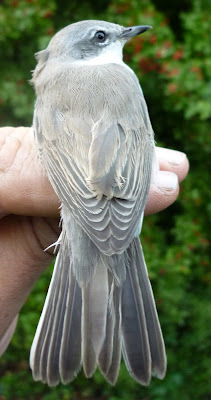238 new birds, 57 retraps (in brackets) of 23 species:
Wren 8 (1)
Dunnock 6 (6)
Robin 6 (7)
Blackbird 10 (8)
Song Thrush 8 (1)
Sedge Warbler 1 (0)
Reed Warbler 24 (1)
Whitethroat 25 (6)
Lesser Whitethroat 2 (0)
Garden Warbler 19 (2)
Blackcap 91 (8)
Chiff Chaff 2 (3)
Willow Warbler 2 (1)
Blue Tit 8 (5)
Great Tit 6 (3)
Long Tailed Tit 0 (1)
Chaffinch 3 (0)
Goldfinch 10 (0)
Greenfinch 1 (0)
Bullfinch 4 (3)
Treecreeper 0 (1)
Sparrowhawk 1 (0)
Wood Pigeon 1 (0)
We'll start with the standout total for Blackcap. This site has always been good for Blackcaps - more Blackcaps have been ringed than just about all other species in the park. The total above includes birds caught outside the CES. On Saturday 27th August I caught 26 Blackcaps (the majority new and the majority male). These birds must have moved on and another lot moved in as by the following Wednesday (31st August) I caught 30 Blackcaps (only one retrap from the weekend and only because it's from a late brood & not ready to go yet).
I call on all ringers north of Bedfordshire to get a move on and ring some Blackcaps! Out of all the Blackcaps I've ringed here in the last week or two, none have been ringed other than on site. You can increase my chances of catching one of your birds!

Above: Female Blackcap

Above: Male Blackcap

Above: This bag contains a big living ball of feathers (see below)!

Above: A Wood Pigeon (the big ball of feathers).

Above: A Lesser Whitethroat. This bird represents one of two ringed on 27th August. This species used to be more regular in the park but there have been very few records this year. I assume therefore that these two birds (juveniles) were migrating through the park (we would likely have caught the adults & juveniles earlier if they had bred).

Above: Normally seen in the skys above & normally too good at airobatics to be caught. This juvenile Sparrowhawk is obviously still learning then!


No comments:
Post a Comment